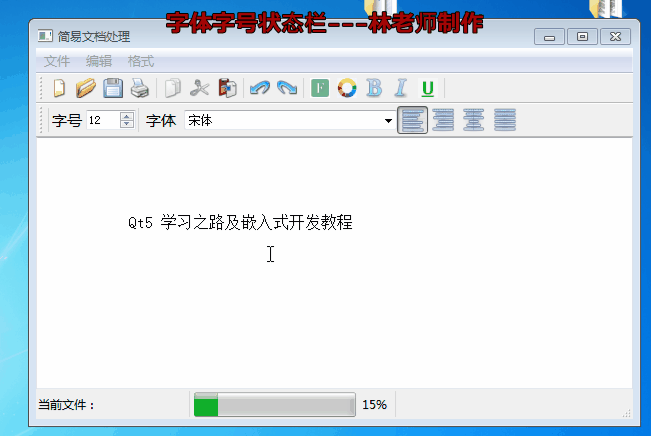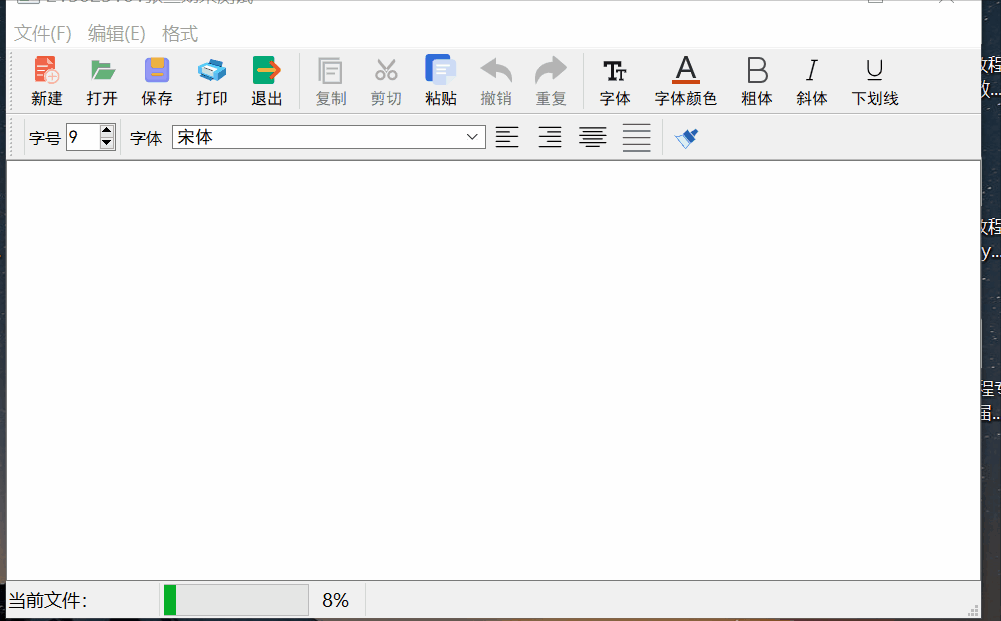Qt5 学习之路及嵌入式开发教程18:Qt5主窗口---字体字号状态栏
这次任务要完成Qt5主窗口的界面设计第五部分:字体字号状态栏功能实现

无法用控件完成,只能用代码完成。
步骤:
1、在mainwidow.h中添加代码
#include <QSpinBox>
#include <QFontComboBox>
在类定义内:
private:
QLabel *fLabCurFile;
QProgressBar *progressBar1;
QSpinBox *spinFontSize;
QFontComboBox *comboFont;
void iniUI();
添加槽函数:
private slots:
void on_spinBoxFontSize_valueChanged(int aFontSize);
void on_comboFont_currentIndexChanged(const QString &arg1);
2、在mainwindow.cpp中变量初始化、功能实现
变量和函数初始化:
void MainWindow::iniUI()
{
fLabCurFile = new QLabel;
fLabCurFile->setMinimumWidth(150);
fLabCurFile->setText("当前文件:");
ui->statusBar->addWidget(fLabCurFile);
progressBar1 = new QProgressBar;
progressBar1->setMaximumWidth(200);
progressBar1->setMinimum(5);
progressBar1->setMaximum(50);
progressBar1->setValue(ui->textEdit->font().pointSize());
ui->statusBar->addWidget(progressBar1);
spinFontSize = new QSpinBox;
spinFontSize->setMinimum(5);
spinFontSize->setMaximum(50);
spinFontSize->setValue(ui->textEdit->font().pointSize());
spinFontSize->setMinimumWidth(50);
ui->toolBar->addSeparator();
QLabel *lb_1 = new QLabel("字号 ");
QFont ft("Microsoft YaHei", 11);
lb_1->setFont(ft);
ui->toolBar->addWidget(lb_1);
ui->toolBar->addWidget(spinFontSize);
ui->toolBar->addSeparator();
QLabel *lb_2 = new QLabel(" 字体 ");
QFont ft2("Microsoft YaHei", 11);
lb_2->setFont(ft2);
ui->toolBar->addWidget(lb_2);
comboFont = new QFontComboBox;
comboFont->setMinimumWidth(100);
ui->toolBar->addWidget(comboFont);
setCentralWidget(ui->textEdit);
}
在ui->setupUi(this);下一行添加
iniUI();
槽函数:
connect(spinFontSize,SIGNAL(valueChanged(int)),this,SLOT(on_spinBoxFontSize_valueChanged(int)));
connect(comboFont,SIGNAL(currentIndexChanged(QString)),this,SLOT(on_comboFont_currentIndexChanged(QString)));
功能实现:
void MainWindow::on_spinBoxFontSize_valueChanged(int aFontSize)
{
QTextCharFormat fmt;
fmt.setFontPointSize(aFontSize);
ui->textEdit->mergeCurrentCharFormat(fmt);
progressBar1->setValue(aFontSize);
}
void MainWindow::on_comboFont_currentIndexChanged(const QString &arg1)
{
QTextCharFormat fmt;
fmt.setFontFamily(arg1);
ui->textEdit->mergeCurrentCharFormat(fmt);
}
3、运行结果:

添加格式刷部分
定义变量及函数部分
1、在头文件中添加
//格式刷初始化
void initalFormatBrush();
//重写事件过滤器,实现点击松开改格式
bool eventFilter(QObject* obj,QEvent* e);2、定义格式刷变量
private:
QAction *actionFormatBursh; //格式刷
QTextCharFormat brushCharFormat; //格式刷储存的字体3、定义槽函数
private slots:
//格式刷
void showFormatBrush();初始化及函数实现部分
1、构建函数内
//注册ui->textEdit 事件过滤器 如果要监听QTextEdit 控件的鼠标事件,在
//ui->textEdit->installEventFilter(this);
ui->textEdit->viewport()->installEventFilter(this);
//格式刷初始化
initalFormatBrush();2、功能部分
/************格式初始化****************/
void MainWindow::initalFormatBrush()
{
//设置分割线
ui->toolBar_2->addSeparator();
//格式刷
actionFormatBursh=new QAction(QIcon(":/formatBrush.png"),"格式刷");
ui->toolBar_2->addAction(actionFormatBursh);
connect(actionFormatBursh,&QAction::triggered,this,&MainWindow::showFormatBrush);
}//重写事件过滤器,实现点击松开改格式
bool MainWindow::eventFilter(QObject *obj, QEvent *e)
{
if(obj==ui->textEdit->viewport()){
if(actionFormatBursh->isCheckable()){
//触发格式效果
//鼠标点击,获取该光标处字体信息
if(e->type()==QEvent::MouseButtonPress){
//qDebug()<<"按下";
QMouseEvent* ev=static_cast<QMouseEvent*>(e);
if(ev->button()==Qt::LeftButton){
QTextCursor textCursor=ui->textEdit->textCursor();
this->brushCharFormat = textCursor.charFormat();
//qDebug()<<this->brushCharFormat.fontPointSize();
}
}
//鼠标释放更改字体
if(e->type()==QEvent::MouseButtonRelease){
//qDebug()<<this->brushCharFormat.fontPointSize();
//qDebug()<<"释放";
QMouseEvent* ev=static_cast<QMouseEvent*>(e);
if(ev->button()==Qt::LeftButton){
ui->textEdit->setCurrentCharFormat(brushCharFormat);
showFormatBrush();
}
}
}
}
return QObject::eventFilter(obj,e);
}void MainWindow::showFormatBrush()
{
if(!actionFormatBursh->isCheckable()){
actionFormatBursh->setCheckable(true);
actionFormatBursh->setChecked(true);
QCursor cursor;
QPixmap pixmap(":/cursorBrush.png");
QSize picSize(26,26);
QPixmap scaledPixmap = pixmap.scaled(picSize, Qt::KeepAspectRatio);//按比例缩放
cursor=QCursor(scaledPixmap);
ui->textEdit->viewport()->setCursor(cursor);
}else{
actionFormatBursh->setCheckable(false);
actionFormatBursh->setChecked(false);
ui->textEdit->viewport()->setCursor(QCursor(Qt::ArrowCursor));
}
}功能演示:























 1170
1170











 被折叠的 条评论
为什么被折叠?
被折叠的 条评论
为什么被折叠?








